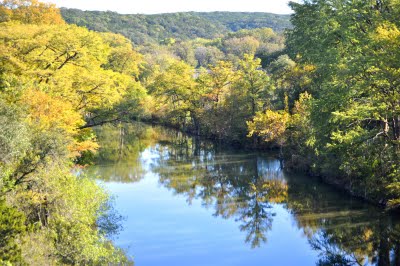Reflective surfaces can be a great photography tool. They come in both natural (water) and manmade (mirror) forms. Not only can they add an interesting element to your photos, but they also boost the amount of light in your picture. These surfaces can be used as a basic aspect of your photo, or alone as an artistic shot. Here are a few examples ~
I took this photo during a walk through my neighborhood (yes, I sometimes bring my D5000 on exercise walks with me). The road wasn't particularly visually interesting, though it's pretty curvy, so when I saw the mirror attached to a telephone pole I knew it would make a great, artsy shot. Because I couldn't move the mirror, I had to angle myself and my camera so the road lined up in the mirror. The result is a fun shot using an unusual method.
Here's another example of using a manmade reflective surface. I took this photo during a snowmobiling outing in Lake Tahoe. I had gotten a bunch of great shots of the scenery and noticed how the gorgeous blue sky was reflected in Gilda's helmet. I thought it would be fun to get a picture of it and I also knew that my reflection would be captured too. Since a photographer isn't often the subject of many photos, this was a nice bonus. I guess that's how many people see me anyway, with a camera pressed to my face. I love that I captured me, Richard, the sky and landscape all in one shot. I also like that I used the helmet to achieve this because it gives a real feeling for what we were doing.
This is a picture from my cousin's wedding in Texas of the river that ran beside the resort. I liked that both the trees and sky were reflected in the river. It really gives a feeling for how calm the water was and how relaxing the experience was.
This was another shot that was purely for artistic expression. The clouds that day were almost cartoon-like in their fluffiness against the clear blue sky. I saw the puddle on the ground and thought it would be fun to picture the sky reflected in it. The result is what looks like a puddle full of sky and clouds.
This shot of the Golden Gate Bridge, taken from the Marin Headlands, is another example of using water to reflect light. As you can see, it was a cloudy day, so the light was diffuse and was reflecting nicely on the water of the Bay. It also meant that the shadow of the bridge span was cast on the water very distinctly. I made sure to adjust my settings in this shot so that the dark and light areas of the clouds were defined and the same was reflected in the water.
This photo of the Washington Monument and Capitol Building was taken from the Lincoln Memorial and I felt that it was important for me to capture the reflecting pool as well. See, even the architects of D.C. knew the importance of reflective surfaces. In this instance (a dark night shot) the reflection was also important because it nearly doubled the amount of light in the shot.
So, now you know how to use reflective surfaces to make your photos more interesting. When dealing with these surfaces and how they interact with your light source, you may have to adjust the settings on your camera to maximize the effect. Just mess around with it!












 meghaninwonderland@gmail.com
meghaninwonderland@gmail.com

0 comments to blog for:
Post a Comment